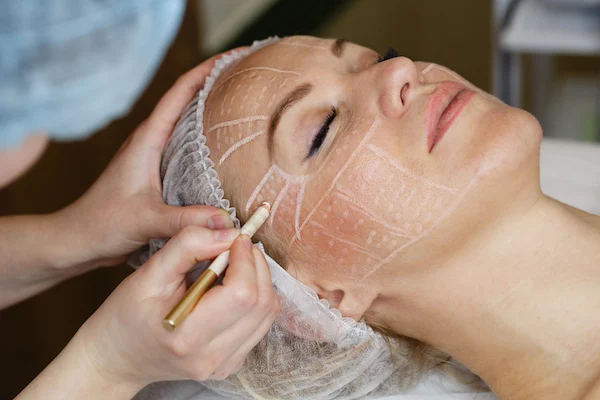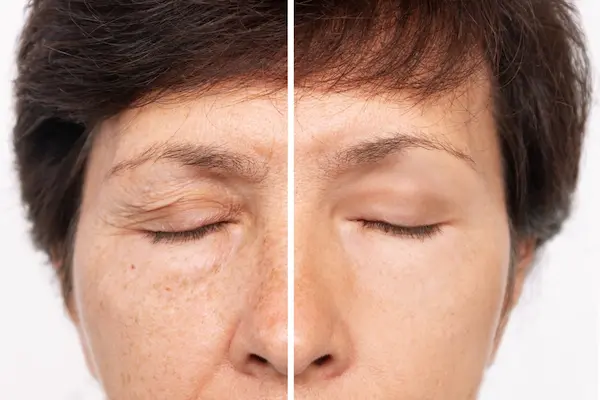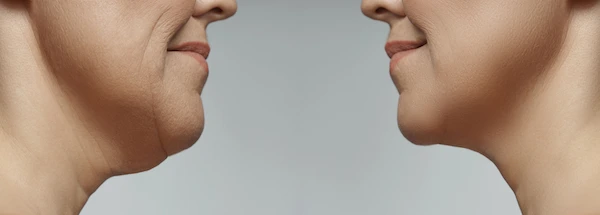Introduction To Facelifting Techniques
As we grow older our skin loses its firmness and the pull of gravity leads to wrinkles drooping skin and an aged look. Facelift surgery, also called rhytidectomy aims to refresh the face by tightening the underlying muscles and removing skin resulting in a youthful appearance. This cosmetic procedure has become increasingly popular as people strive to maintain a look and enhance their self esteem.
In this blog article we will discuss facelift methods, their advantages, possible risks and factors to consider when selecting the type of incision. Whether you’re contemplating a facelift or simply curious, about the procedure this post offers insights and guidance to assist you in making a choice.

Types Of Facelifting Techniques
Face lifting ways can split into two types: old-school lifts and less-cut lifts. Each way has its own good points. They are made to fix certain things and give the look you want.
Old-style Lifts:
Old-style lifts, or cut lifts, are the full-on and deep option. They involve cuts along the hair, near the sides of the head, and sometimes back past the ears. Through these cuts, the doc gets to the deep layers and muscles. The skin gets lifted up, and the deep parts get pulled tight. This makes you look younger and more pulled up. Any too much skin gets cut off to make the new look even better.
Old-style lifts work best for those with a lot of aging, like big sagging or too much skin on their cheeks, jaw, and neck. These give a big change that lasts longer than simple lifts, but they also take longer to heal. The new look can stay for 10 years or more if you take care and live well.
Simple Lifts:
Simple lifts are now a big deal because they cut less and heal fast. These include thread lifts and liquid lifts.
Thread lifts use threads that go away with time, put under the skin to pull up and move the face stuff. These threads hold in certain spots to lift a little, mainly fixing the cheeks, jaw, and brow. The change lasts about 1-3 years, then the threads go away, and you might need to do it again to keep the look.
Is A Facelift Right For Me?
Deciding whether to undergo a facelift is a choice that involves carefully considering various factors. Factors such, as age, skin firmness, the extent of drooping and overall health are aspects to think about when making this decision.
Typically people in their 40s to 60s with signs of aging in the mid neck regions are often seen as good candidates for a facelift. During this phase of life factors like gravity, sun exposure and natural aging can cause sagging skin, the development of jowls and a loss of definition in the jawline and neck. A facelift can address these issues by tightening and repositioning muscles and tissues underneath the skin resulting in a revitalized look.
It’s crucial to have expectations and realize that a facelift is not a fix, for aging. While it can greatly enhance your appearance and reverse some signs of aging it cannot completely stop the aging process. Over time the effects of a facelift may lessen gradually requiring touch ups or procedures to maintain the desired outcome.
When you meet with a certified plastic surgeon they will carefully assess your features, skin condition and the results you want to achieve. This evaluation is important, in deciding whether a facelift is the choice, for addressing your needs and objectives.
Benefits Of Facelifting
The main good thing about a face lift is a look that seems young and fresh. By making tight the deep face parts and taking away too much skin, a face lift can make less of deep lines, droopy skin, and heavy cheeks. This makes your face look more smooth, tight, and sharp. Such a change can shave off years from how you look and bring back a young and full of life face.
A face lift not just helps how you look, but it also lifts how you feel about yourself. When you like how you look, it can help in many parts of your life, like with friends and at work, meeting new folks, and how good you feel overall.
It’s key to know that a face lift can’t stop age from moving on. But if you take good care of your skin and stay healthy, a face lift can keep you looking good for many years. You might need extra small fixes or steps later on.
Complications of the facelift procedure
Facelifts, like any surgical procedure, have risks and complications. This includes bleeding, infection, scarring, nerve damage, hair loss along the incision line or allergies to anesthesia. However, these risks are generally low when the procedure is performed by a skilled and experienced plastic surgeon following safety protocols properly and industry standards.
Scarring is one of the most common problems associated with facelifts. Although incisions are made to minimize visible scars to some extent such scarring is inevitable. Nonetheless, these scars often fade away over time with proper post-operative care.
Another risk that may be associated with a facelift is nerve damage. This may cause temporary or permanent numbness in certain parts of your face or even weakness as well as paralysis. Consequently, your surgeon will take precautions to prevent the occurrence of this condition in you although it’s still possible.
It’s very important to talk about all possible complications and risks with your doctor before getting into the surgery room therefore. They will guide you on how to get ready for it in detail at least including what you can anticipate throughout healing process besides ways of lowering chances of such hardships from occurring.
Facelift Incision For Parotidectomy
There are instances where incisions for facelift pharyngostomies may be necessary such as in patients undergoing a parotidectomy. The gland is situated in front of the ear and it may have to be removed due to different conditions like tumors, chronic inflammation or any other medical cause.
The facelift incision therefore offers a useful entry for the surgeon when performing a parotidectomy while at the same time giving room for facial rejuvenation. Thus, during this combined procedure, the surgeon makes an incision that runs along the hairline and curves around the ear just as it does in traditional facelifts.
This intelligent incision has two major benefits associated with it. Firstly, it allows easy access to the parotid gland thus facilitating its safe removal. Secondly, once it has been successfully extracted, this enables the surgeon to easily switch gears towards commencing on a facelift surgery part of it. This is done by tightening underlying facial muscles, repositioning tissues and taking out extra skin which results into a more youthful look.
Parotidectomy can be done together with face-lifting so that both medical and cosmetic concerns can be addressed simultaneously. Hence multiple separate operations can be avoided through this approach

Male Facelift Incisions
For male face lifts, cuts are often made to fit a man’s own face shape and shaving style. Men have hairlines and beard hair that stand out more, which can hide or show the cuts from surgery better.
A common cut path for men’s face lifts runs by the hair on the head, down by the front of the ear, then back around the ear and into the lower hair area. This plan lets doctors fix and pull tight the muscles and stuff under the skin without showing scars much, since beard hair can hide leftover marks.
The cut by the hair is put in a way that uses the hair’s natural lines to make sure any possible scars are hidden well by hair. Also, the cut behind the ear and down the back uses the skin’s own lines and folds to hide the surgical cuts better.
Sometimes, doctors might add more cuts to the face lift plan for men to get better access and the best look. For example, cuts might be put in the beard or by the side of the face where hair hides the area, letting the doctor lift and tighten the face more.
A doctor’s skill and care are key in planning the cuts for a male face lift. They must think about each person’s face, hair, and what they want to look right, to come up with a plan that doesn’t just make the face look younger but also keeps cuts from being seen after surgery.
By making the cut plan fit a man’s face and how he grooms, surgeons can give great face lift results that make him look young and fresh again while keeping his manly looks and hiding any clear signs of the surgery.
Female Facelift Incisions
For women getting facelifts, doctors cut the skin in a way that fits hairdos, face shapes, and how much younger they want to look. They aim to make cuts that hide well in face lines and by the hair, so the change looks real and hard to spot.
The cut that is used a lot starts at the hair by the temple, goes down around the ear, then to the back of the ear and into the hair on the back of the head. This plan lets the doctor fix droopy skin and extra flab on the cheeks, jaw, and neck. It also means scars can hide in the hair and face folds.
The cut along the hairline is drawn to match the way the hair grows, so it hides any leftover scars. The same is true for cuts behind the ear and on the back of the head—they use the skin’s creases to hide scars better.
Sometimes, extra cuts are needed for the top part of the face. Cuts can be made in the eyelid or brow to lift saggy brows or take away extra skin on the top lids. These cuts also hide in the face’s natural lines for a true-to-life look.
The doctor’s skills in making the cut plan for a woman’s facelift are very important. They think carefully about each person’s face, hair, and what they want to look younger but in a way that hides scars well.
By making the cut plan just right for each patient’s face and what they hope to fix, doctors can make great changes. They bring back a fresh, young look while keeping the face’s natural charm and hiding any signs of the surgery.

Factors To Consider When Choosing A Facelift Incision
Taking into account many different things is necessary for selecting a proper method of facelift incision. These include how old the patient is, what condition their skin is in, where their hairline is located, which parts of the face need attention, and how much rejuvenation they want. Shorter cuts may be needed in younger people while longer ones or more than one might be required in older individuals with greater drooping. Incisions are then hidden along hairlines and facial hair patterns. Larger amounts of change that address multiple areas will mean lifting everything up so larger or additional incisions have to be made. The best way for a surgeon to proceed also depends on their skill set and preferred methods of operationing. Ultimately however it is open dialogue between patients and surgeons that will lead them toward the least visible scarring while achieving discreet aesthetic goals with individualized cutting plans that can do this job better than anything else in such cases
Conclusion
As we go through lifes journey the signs of aging inevitably show on our face with wrinkles, loose skin and a loss of glow becoming apparent. Yet facelift procedures present an option, for those looking to rejuvenate their appearance. In this blog post we delved into the nuances of facelift techniques, their advantages, risks and the important factors to consider when selecting the right incision style.
Conventional facelifts entail cuts around the hairline temples and behind the ears to tighten muscles and remove excess skin. Invasive methods such as thread lifts offer a way to achieve subtle lifting effects. Choosing a candidate involves assessing age, skin firmness, drooping areas and overall health status. The perks include a look with fewer wrinkles and less sagging for a confidence boost.
Though complications like bleeding, infections, scarring or nerve issues are uncommon when done by surgeons it’s crucial to be informed. Customizing incision patterns according to characteristics, hairlines and grooming preferences leads to natural looking outcomes for both males and females. The surgeons proficiency plays a role in this process.
If you’re contemplating a facelift procedure seek advice from a certified plastic surgeon who is experienced in the field. Have a conversation, about your objectives and worries so that you can receive tailored recommendations aligned with your requirements.
Getting a facelift is a decision that requires finding an trustworthy professional to take care of you. When you have the surgeon and fully understand the process a facelift can truly transform your life by boosting your confidence and self worth. Don’t be afraid to start your journey, towards feeling refreshed and renewed.

FAQs
How can I tighten my face?
Many ways exist to firm and lift your face without surgery, like doing face workouts, heat wave care, sound wave care, and using shot fillers. Face workouts can make the deep face parts strong and tight. Heat wave and sound wave care boost the making of a key skin protein for a tighter look. Shot fillers can fill out and lift parts like the cheekbones, jaw, and sides of your head, giving a short-term pulled-tight feel.
What is the 20-minute permanent facelift?
The term “20-minute permanent facelift” is a marketing name for a minimally invasive facelift that involves the use of barbed threads or sutures. During this procedure, the surgeon puts dissolvable threads below the skin’s surface. These threads are made with small barbs which catch on to the underlying tissues, thus enabling the doctor to lift and move around facial structures, resulting in a subtle lifting effect.
While it may take only about 20 minutes to carry out this operation, calling it “permanent” is deceptive. The outcomes achieved through such technique cannot be regarded as truly permanent since over time — usually within one to three years — these threads dissolve gradually. In order to keep up with desired lifting effects, touch-up treatments from time to time or repeating the initial surgery once its threads have dissolved might be required by patients.
It should be mentioned that the “20-minute permanent facelift” serves as a less invasive substitute for traditional facelifts; therefore implying shorter recovery periods along with reduced risks related with more extensive surgical procedures. Nonetheless, compared to full surgical facelifts, results are generally less striking and shorter-lasting in nature. Patients must possess realistic expectations concerning temporary outcome prior undergoing this kind of procedure.
Does collagen lift your face?
A key skin protein is vital for keeping your skin stretchy and firm. As time goes by, we make less of this protein, and our skin starts to drop and get lines. While skin cream with this protein may give short moisture and a fuller look, it can’t really pull up or make your face tighter. On the other hand, shots of this protein can fill and lift certain spots, making you look younger, but only for a while.
How can I lift my face without a facelift?
There are fillers that can be injected into the face such as hyaluronic acid or poly-L-lactic acid which do not involve any surgical procedure to lift the face. These fillers add volume and elevate different parts of the face including cheeks, jawline or temples. Another option is thread lift where barbed threads are placed under your skin so as to reposition and lift tissues without extensive invasion. Additionally, radiofrequency and ultrasound treatments make collagen for firmer look and more tautness.
What age is too late for a facelift?
There isn’t a specific age when one should have a facelift. A person’s overall health, skin elasticity and how much they’ve aged all factor into the decision. However, surgeons typically advise patients to get a facelift between the ages of 40 and 70, when signs of aging are more pronounced. For those who are younger or older, there may be less invasive methods or more extensive operations available.
What is the best natural facelift?
There is no such thing as a “natural facelift,” but various non-invasive techniques can create a subtle lifting and tightening effect without surgery. Among these are facial exercises that work out and firm up the muscles beneath the skin, and facial massages that boost blood flow while draining lymphatic fluids — both activities help foster youthful appearances. Also, staying healthy through exercise balanced dieting and proper skincare can preserve elastin in your complexion which will stave off wrinkles longer.
What is the easiest face lift?
The most convenient type of facelift is often called a “liquid facelift” procedure also known as lunchtime facelift because it requires no incision at all hence no scarring. In this type of non-surgical facelift, dermal fillers like hyaluronic acid or poly-L-lactic acid are injected strategically to give volume and life in specific areas such as cheeks, jawline or temples among others. The downtime after having this kind of a facelift is very minimal therefore you can resume your daily activities immediately thus making it one of the best choices for people looking for an understated improvement.
What is the longest-lasting facelift?
The most enduring kind of facelift is often seen as the standard or cutting facelift. This deep-cut method needs cuts to reach the deep face muscles and parts, which are then moved up and made tighter. Too much skin is cut off too, leading to a big and long hold up in the skin’s look. If you take good care of it and live well, the outcome of a cutting facelift can keep for as long as 10 years, maybe even more.
What is the most advanced facelift?
The deep plane lift is known as the most developed facelift procedure or the SMAS lift. Besides tightening and repositioning skin, it also lifts and repositions the underlying muscle layer (SMAS) for a more complete and natural outcome. Sagging in multiple areas such as jowls, midface, neck can be addressed by this advanced technique which gives long-lasting and natural results.
What is the most expensive facelift?
Typically, the most costly facelift combines various procedures depending on the needs of an individual. These may consist of a standard facelift together with complementary surgeries like brow lift, eyelid surgery (blepharoplasty), and neck lift (platysmaplasty). Moreover, expensive features can be added through techniques such as deep plane lifting or fat grafting. Additionally determining overall costs are skills possessed by surgeons as well as their reputations among others they operate on them too which is very important when considering how much should this process cost?.



